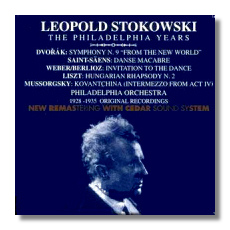
The Internet's Premier Classical Music Source
Related Links
- Latest Reviews
- More Reviews
-
By Composer
-
Collections
DVD & Blu-ray
Books
Concert Reviews
Articles/Interviews
Software
Audio
Search Amazon
Recommended Links
Site News
 CD Review
CD Review
The Stokowski Sound

Part I - "The Philadelphia Years"
- Antonín Dvořák: Symphony #9 "From the New World" ('35)
- Carl Maria von Weber: Invitation to the Dance ('28)
- Camille Saint-Saëns: Danse Macabre ('28)
- Franz Liszt: Hungarian Rhapsody #2 ('28)
- Modest Mussorgsky: Kovanchina: Intermezzo from Act IV ('28)
Philadelphia Orchestra/Leopold Stokowski
Gramofono 2000 AB-78552 Mono
The Stokowski Sound was famous and infamous, but there was a Stokowski Sound. You never hear that of the other "golden era" conductors. The less said about a Toscanini Sound, dead and dry, the better. While other conductors had a definite personality in their music making, it was not as distinctive in shear 'sound' terms as Stokowski.
I had the pleasure, a few years ago, to talk with Maestro Walter Hendl, who had worked with Stokowski when they were both at the New York Philharmonic. I asked Walter how Stokowski got "the sound". He told me that it began in the double basses (of which Stokowski always had a plethora). Then Stokowski would bring it down through the celli through to the other strings. This created an organ-like sonority, a rich tapestry on which to paint his masterpiece.
Stokowski also had a tight control over the recording process. I will go into that in more depth in the next essay (a review of the Stokowski/Tchaikovsky CDs on Philips). He had complete control over what was and was not released. The point is that, especially when wanting to hear a Stokowski recording, the CD you select should incorporate the "Stokowski Sound". If the company releases just anything, not taking care to make sure that such a sound is inherent in the master, then you are not really listening to a Stokowski recording. These thoughts, and more, came to mind while I listened to the Gramofono disc.
I heard about these discs from Mark Obert-Thorn, who had seen them in the local record shop. I hesitated buying a review copy. My experience with Nuova Era/Phonographe, also a "made in Italy" series, had been off-putting. Anyway, I came across a this copy in Toledo and the Stokowski-scholar in me made it necessary I review it.
I took the disc home and began by listening to the 1935 Dvořák 9th. It is essentially the only game in town if you want that particular disc. (There was one put out by the Japanese Stokowski Society some years ago, but it has never really been available.) The sound was good, better than the JLS, but something seemed wrong. Then I got out the two-disc set on Phongraphe (#PH 5025/26) for some A/B comparison. No doubt, the Gramofono had it all over the Phonographe. The former has more detail, the latter sounds like the recording was made with the orchestra in another room.
Then I got out the Biddulph CD that had some of the same music. The first is, Leopold Stokowski Conducts French Music on #WHL 012. It contains the Dance Macabre, as above, but also a "Carmen" Suite, "L'Arlésienne" Suite #1, the Bacchanale from "Samson & Dalila" and the "Carnival of the Animals". The transfers by Mark Obert-Thorn. The other is titled "Stokowski Conducts Dvořák (even though less than half of the disc contains Dvořák) with the 1927 "New World" #WHL 027. It has the Hungarian Rhapsody but also Chopin/Stokowski music and Borodin's Polovtsian Dances. Ward Marston doing the transfers here. The difference was stunning. The Gramofono issue was revealed as being dry (the last thing you want in a Stokowski Sound). The Biddulph recordings had more atmosphere and an almost stereophonic cast. This is the Stokowski Sound!! If you want to hear what Stokowski wanted in the recordings he released have your local dealer get the Biddulph discs and don't waste your money on this disc. This is one of those cases where there ought to be a law.
Copyright © 1995, Robert Stumpf II

















